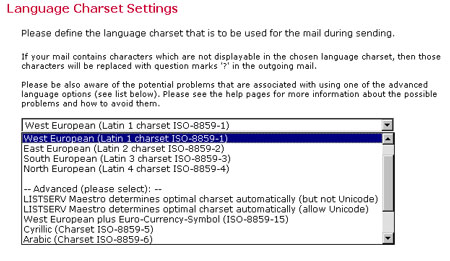Section 1
Introduction
Section 2
The Maestro Interface
Section 3
Defining a Job
Section 4
Defining Recipients
5.5 Langauage Character Set
Tip Language Charset
5.6 Merge Fields and Conditional Blocks
5.7 Merged Parameters within URLs
Section 6
Defining Tracking
Section 7
Sender and Delivery Options
Section 8
Outbox
Section 9
Delivered Jobs
Section 10
Reporting and Statistics
Section 11
User Settings
Appendix A
24 Hour Clock
Appendix B
International Character Sets
Appendix C
Comma Separated Files
Appendix D
AOL Rich Text
5.5 Setting the Language Character Set
A character set (also called charset, character encoding, code page or character page) is simply a table that matches numbers (the digital information sent by computers over the Internet) to letters, or more precisely, characters. Due to the nature of digital information and e-mail - all data is reduced to numeric code - there is a finite number of "positions" in this table to correspond to letters and other symbols of a language. Therefore different charsets have been developed to correspond to the different letters and symbols for different languages. A charset will not translate one language to another; it only encodes data to match positions in the table to specific characters. For example, in the charset ISO-8859-1 (matching an alphabet suitable for West-European languages), the position number 196 represents the umlaut Ä. The same position, 196, using the charset ISO-8859-7 (the Greek alphabet), matches the Greek letter Δ. As a result, the same position number in the table will result in different characters being displayed, depending on the charset used for the encoding. For more information on this subject, see Appendix B International Character Sets in this guide.
LISTSERV Maestro defaults to the ISO-8859-1 (Latin 1) character set for encoding e-mail messages (unless a different default setting has been preset by the system administrator). LISTSERV Maestro supports other charsets, and if users are given the right to use other character sets, an active link will appear at the end of the sentence "Language: Mail will be sent with language charset for..." on the screen. The link will be different depending on whether a different selection has previously been made. The default link is West European (Latin 1 charset ISO-8859-1).
To choose a different charset, click the active link after "Language:" The Language Charset Setting screen will open. Select a charset from the drop-down menu and then click OK.
Figure 29 Language Charset Settings

![]() If LISTSERV Maestro is being used in a single language environment, either
with plain English or with one of the common (West) European languages,
the safest choice for a character set (charset) is always ISO-8859-1 (Latin
1) charset. It contains all 26 common characters (both in upper and lower-case),
all the common punctuation characters and the more common special characters
like '@', '+', '*', and others. In addition, it contains the more uncommon
characters required for most West European languages, like 'ö', 'å', 'ç'
and others.
If LISTSERV Maestro is being used in a single language environment, either
with plain English or with one of the common (West) European languages,
the safest choice for a character set (charset) is always ISO-8859-1 (Latin
1) charset. It contains all 26 common characters (both in upper and lower-case),
all the common punctuation characters and the more common special characters
like '@', '+', '*', and others. In addition, it contains the more uncommon
characters required for most West European languages, like 'ö', 'å', 'ç'
and others.
It is not always necessary or possible to change the charset for e-mail messages. Using other charsets can become quite complex, especially when merged data is involved. Each charset has advantages and disadvantages that are described in greater detail in the online help and in Appendix B International Character Sets of this guide.